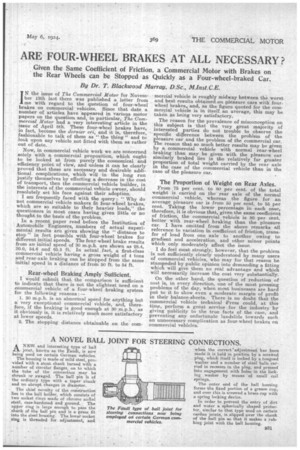ARE FOUR-WHEEL BRAKES AT ALL NECESSARY?
Page 17

If you've noticed an error in this article please click here to report it so we can fix it.
Given the Same Coefficient of Friction, a Commercial Motor with Brakes on the Rear Wheels can be Stopped as Quickly as a Four-wheel-braked Car.
By Dr. T. Blackwood Murray, D.Sc., M.Inst.C.E.
1 N the issue of The Commercial Motor for November 13th last there was published a. letter from me with regard to the question of four-wheel brakes on commercial vehicles. Since that date a number of articles have appeared in various motor papers on the question, and, in particular, The Com mercial om mercial Motor had a very interesting article in the issue of April 8th. These four-wheel brakes have, in fact, become the dernier cri, and it is, therefore, fashionable to talk of them as "the thing " and to look upon any vehicle not fitted with them as rather out of date.
Now, in commercial vehicle -work we are concerned solely with a commercial proposition, which ought to be looked at from purely the economical and efficiency point of view, and unless it can be clearly proved that these are necessary and desirable additional complications, which will in the long run justify themselves by effecting a decrease in the cost of transport, then the commercial vehicle builder, in the interests of the commercial vehicle owner, should resolutely set his face against their adoption.
I am frequently faced with the query: "Why do not commercial vehicle makers fit four-wheel brakes, which are so suitable to their heavier loads," the questioners in most cases having given little or no thought to the basis of the problem.
In a recent paper read before the Institution of Automobile Engineers, numbers of actual experimental results are given showing the "distance to stop" in feet possible with four-wheel brakes for different initial speeds. The four-wheel brake results from an initial speed of 30 m.p.h. are shown as 28.4, 30.0, 54.6 and 65.5 ft. In actual fact, a first-class commercial vehicle having a gross weight of 4 tons and rear-axle braking can be stopped from the same initial speed in a distance of from 50 ft. to 54 ft.
Rear-wheel Braking Amply Sufficient,
I would submit that the comparison is sufficient to indicate that there is not the slightest need on a commercial vehicle of a four-wheel braking system for the following reasons :— 1. 30 m.p.h. is an abnormal speed for anything but a very exceptional commercial vehicle' and, therefore, if the braking is good enough at 30 m.p.h., as it obviously is, it is relatively much more satisfactory at lower speeds.
2. The stopping distance obtainable on the com
mercial vehicle is roughly midway between the worst and best results obtained on pleasure cars with fourwheel brakes,, and, as the figure quoted for the commercial vehicle is in itself an average, this may be taken as being very satisfactory.
The reason for the prevalence of misconception on this subject is that the very great majority of interested parties do not trouble to observe the specific difference between the problem of the pleasure car and the problem of the commercial car. The reason that so much better results may be given by a commercial vehicle with normal rear-wheel braking than may be given with the pleasure car similarly braked lies in the relatively far greater proportion of total weight carried by the rear axle in the case of the commercial vehicle than in the case of the pleasure car.
The Proportion of Weight on Rear Axles.
From 75 per cent. to 80 per cent. of the total weight is carried on the rear axle of the normal commercial vehicle, whereas the figure for an average pleasure car is from 50 per cent. to 55 per cent. Taking the lower percentage in each case, therefore, it is obvious that, given the same coefficient of friction, the commercial vehicle is 50 per cent. better -with rear-wheel braking than the pleasure car. I have omitted from the above remarks all reference to variation in coefficient of friction, transfer of load from one axle to another owing to gradient and acceleration, and other minor points which only moderately affect the issue.
I do feel most strongly, however, that the problem is not sufficiently clearly understood by many users of commercial vehicles, who may for that reason be stampeded by public opinion into demanding a fitting which -will give them no real advantage and which will necessarily increase the cost very substantially.
On the other hand, the question of reduction of cost is, in every direction, one of the most pressing problems of the day, when most businesses are hard put to it to show even a moderate margin of profit in their balance-sheets. There is no doubt that the commercial vehicle technical Press could, at this time, perform a great service for the industry by giving publicity to the true facts of the case, and preventing any unfortunate landslide towards such an unnecessary complication as four-wheel brakes on commercial vehicles.


































